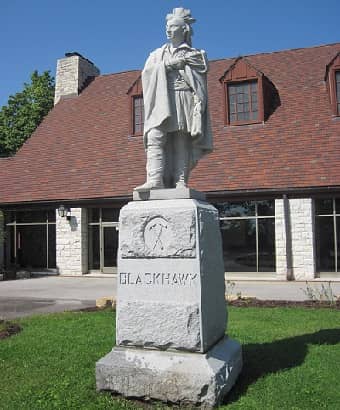
Chief Black Hawk Facts
Chief Black Hawk (also called Black Sparrow Hawk) was a famous Native American warrior and chief of the Sauk tribe. This famous Indian chief's Sauk name is Ma-Ka-Tai-Me-She-Kia-Kiak, which translates to "be a large black hawk". On this page you will find lists of interesting facts about this great Sauk chief, including why he fought the U.S. in the War of 1812 and how the Black Hawk War started. This information is written for both kids and adults.
Click here for a great selection of books about Chief Black Hawk on AMAZONChief Black Hawk Early Life
- Chief Black Hawk was born in 1767 in the village of Saukenuknear near present-day Rock Island, Illinois.
- His father was a respected Sauk medicine man named Pyesa.
- Black Hawk's wife name was As-she-we-qua (Singing Bird). They had five children together. She died in 1846.
- His first experience in battle was at the young age of 15 when he participated in a raid on a rival tribe and killed his first enemy.
- As a young man, Black Hawk was anxious to prove himself as a warrior and participated in many raids on enemy tribes; he led many of the raids.
- Black Hawk's importance in his tribe increased when his father, a medicine man, was killed in battle, and he inherited his medicine bundle.
- Due to his success as a warrior and in leading war parties, he rose to the status of "war chief" (also called war leader or war captain).
- In 1804, the Treaty of St. Louis was signed, which ceded a large amount of Indian Territory to the United States in exchange for money. Chief Black Hawk never accepted the validity of this treaty, and it is what compelled him to side with the British in the War of 1812 and led to the Black Hawk War in April of 1832.
Chief Black Hawk and the War of 1812
- Angered by the loss of Indian Territory to the U.S. from the 1804 Treaty of St. Louis, including his home Saukenuknear, Black Hawk sided with the British against the United States in the War of 1812.
- Black Hawk led a group of warriors from several Indian tribes that sided with the British during the War of 1812, fighting against the United States.
- Chief Black Hawk was involved in numerous battles during the War of 1812, including Fort Stephenson, the Battle of Frenchtown, the Battle of Credit Island, and the Battle of the Sink Hole.
The Black Hawk War
- The foundation of the Black Hawk War was Black Hawk's anger over the 1804 Treaty of St. Louis, which resulted in the loss of a large amount of Indian Territory, in the current states of Missouri, Illinois, and Wisconsin, to the United States Government.
- In 1828, the Sauk and Fox tribes, including Chief Black Hawk, were relocated from their homelands in Illinois and forced to move west of the Mississippi River based on the Treaty of St. Louis.
- Before the beginning of the war, Back Hawk led several Indians back into Illinois; each time, he withdrew back across the Mississippi River without incident.
- In 1832, Black Hawk once again ventured into Illinois with a band of warriors in an attempt to reclaim Indian Territory lost in the Treaty of St. Louis.
- Violence broke out on May 14th of 1832 with the Battle of Stillman's Run, in which the Native American warriors caused the U.S. militia to retreat.
- Numerous violent battles and confrontations occurred during the war.
- Black Hawk surrendered on August 27th of 1832.
- The Black Hawk War was the last Indian War east of the Mississippi River.
Chief Black Hawk Conclusion
- After the Black Hawk War, Chief Black Hawk was taken prisoner by the United States. Black Hawk, along with several other Native American leaders, were taken around the U.S., where large crowds rushed to see them; they even met with President Andrew Jackson. The men were eventually sent to prison for just a few weeks, at Fortress Monroe in Virginia.
- After being released from prison, Chief Black Hawk moved back to Iowa.
- With the aid of interpreters, Black Hawk published his autobiography in 1833. Click here to purchase it on Amazon.com. It was one of the first autobiographies by a Native American and became a bestseller.
- Chief Black Hawk became ill and died on October 3rd of 1838 in Davis County, Iowa.
- In 1838, the year that he died, he gave a speech in which he is quoted as saying, "I thank the Great Spirit that I am now friendly with my white brethren".
- Standing 125 feet (38.1 meters) high in Lowden State Park on a bluff overlooking the Rock River near Oregon, Illinois stands the Black Hawk Statue (also called the Eternal Indian). Dedicated on July 1st of 1911, it was added to the U.S. National Register of Historic Places in 2009.